Effective Ant Control Strategies for Your Yard
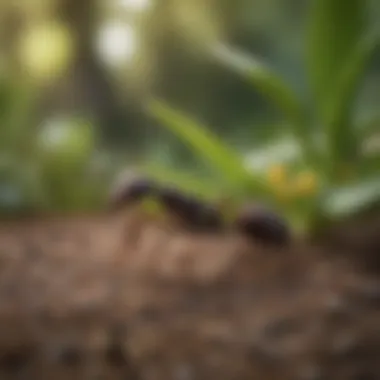

Intro
Ants can be more than just a nuisance in your yard; they can disrupt your garden's ecosystem, munch on plants, and even deter helpful insects. They often create unsightly mounds and can invade homes, posing logistical challenges. For homeowners, understanding how to tackle these tiny intruders effectively is key. This article offers a thorough exploration of strategies to eliminate ants from your outdoor space, helping you reclaim your garden.
We'll go over everything from knowing the common ant species that may invade your yard to practical treatments, both natural and chemical. Also, you’ll learn how to identify warning signs of an infestation, thus preventing future problems. The focus stays on sustainable methods, which ensure the health of your garden while keeping those pesky ants at bay.
Ant behavior, which can seem complex, plays a vital role in how you approach their control. This understanding sets the stage for effective action, complemented by a glance at recent trends in gardening that encourage maintaining a balanced ecosystem.
Key Insights and Trends
When dealing with ants, awareness of current practices can be beneficial. The gardening world has been leaning towards more organic methods lately. These trends, such as companion planting and natural pest deterrents, can help reduce ant problems while also enriching your soil.
Moreover, it’s notable that some communities are actively promoting the use of beneficial insects. Introducing ladybugs or lacewings to your garden can create a more stable environment where ants are kept in check. Keeping a vibrant garden is essential; it benefits not only homeowners but also local wildlife.
"A healthy garden isn’t just about the blooms, it’s about the balance of life within it."
Practical Tips and How-To Guides
Understanding Ant Behavior
To effectively control ants, first, you'll want to understand their behaviors and patterns. Here are a few notable characteristics:
- Foraging: Ants often travel in straight lines, looking for food sources.
- Nesting: They create nests close to food sources or in shady areas.
- Colonial: Ants work in groups, which means where there's one, more are bound to appear.
Identifying Common Species
Next, identifying the type of ant is crucial for treatment as different species may require different strategies. For example:
- Carpenter Ants: These can damage wood structures.
- Pavement Ants: Known for creating mounds on sidewalks or driveways.
- Fire Ants: Aggressive, with a painful sting, often found in southern regions.
By knowing what you're dealing with, you can target your approach effectively.
Step-by-Step Ant Removal Plan
- Observation: Spend some time watching the ants to determine where they are coming from and going to.
- Clean Up: Remove food sources that attract ants; crumbs and spills need to be swiftly cleaned.
- Natural Deterrents: Use substances like vinegar or citrus; these can disrupt their scent trails and deter them.
- Boric Acid: For a chemical option, a boric acid bait can be effective. The ants take it back to their nests, working from the inside out.
- Consulting Experts: If all else fails, it may be wise to call in pest control professionals who can assess and deal with the issue appropriately.
Arming yourself with knowledge lays the groundwork for a successful endeavor against ants. Knowing their habits and identifying the species allows you to formulate an effective plan and reclaim the serenity of your garden.
Preface to Ants in the Yard
When you step outside into your yard, you might be greeted by many sights and sounds of nature—but nothing seems to capture attention quite like the sight of ants hustling about. While some may brush off their presence as a minor nuisance, understanding ants is critical for anyone hoping to maintain a flourishing garden or outdoor space. Ants play a complex role in our ecosystems, and knowing how to effectively manage them can make a world of difference for your greenery.
Understanding the Presence of Ants
So, why are ants so drawn to our yards? It all boils down to a few key factors.
- Food Sources: Ants are instinctual foragers. Their eyes are always on the lookout for food – be it honeydew from aphids, fallen fruit, or crumbs from our picnics. If there’s a smorgasbord of leftovers lying around, you can bet that ants will come marching in.
- Shelter: Ants set up camp in places that provide safety from weather or predators. Cracks in your patio stones or piles of leaves could very well serve as a five-star dining establishment and hotel for these hardy little creatures.
- Moisture: Just like humans, ants need water to survive. If your yard is a bit on the damp side, whether from overwatering your plants or from natural conditions, ants will likely take notice and move in.
Honing in on the reasons why ants are enticed by your yard can guide your approach to addressing any infestations you may face. Not only does it enable you to take proactive measures, but it also sets a solid foundation for understanding their behavior moving forward.
"Ants can bring life and vigor to a garden, but at times can become uninvited guests that need to be managed strategically."
When tackling an ant problem, knowledge is power. Recognizing their attractive habitats in your yard allows you to be one step ahead. From identifying what draws them to better understanding their habits, homeowners can arm themselves with strategies that are effective and sustainable. The road to a harmonious yard is paved with a balance of recognizing these small creatures' roles and knowing when they can spoil your outdoor enjoyment.
Identifying the Type of Ant
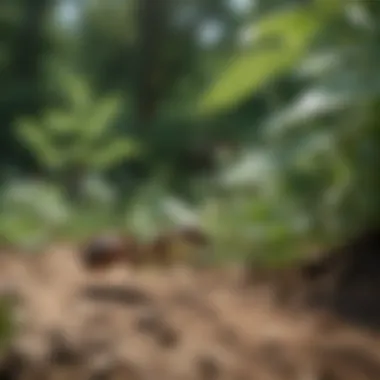
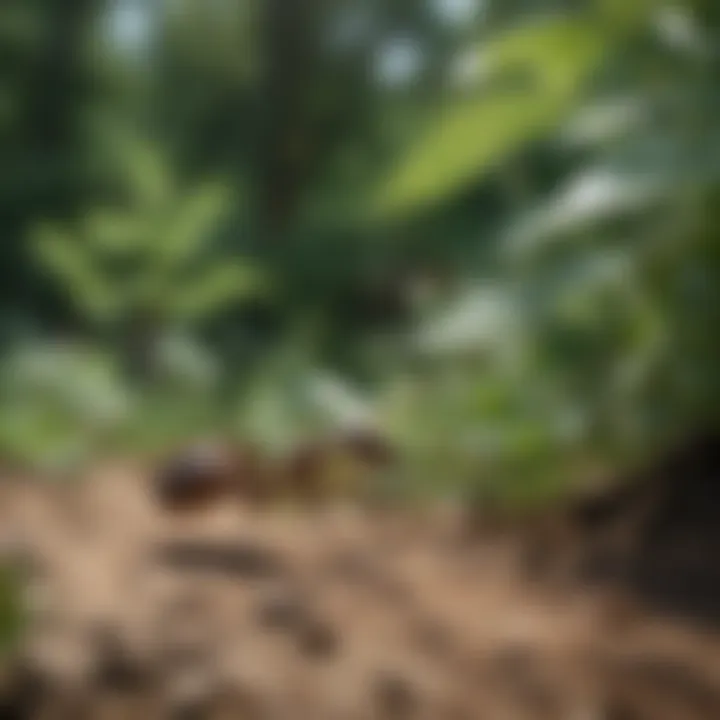
To effectively manage an ant problem in your yard, it's crucial to start by identifying the type of ant that has taken up residence. Different species of ants exhibit varied behaviors, nest typically in distinct locations, and respond differently to control methods. Knowing what you're dealing with can greatly influence the strategy you select for both removal and prevention.
Ants are not just pests; they are also vital players in our ecosystem. Yet, when they begin to invade your home or disrupt your garden, it’s time for action. Some ants can be more invasive, while others may play a beneficial role, such as aiding in soil aeration. Thus, understanding these distinctions is fundamental to balancing pest control with ecological health.
Common Ant Species Found in Gardens
Across many neighborhoods in the U.S., you'll likely encounter several common ant species. Here's a brief look at a few of them:
- Carpenter Ants: Known for tunneling into wood, carpenter ants create elaborate nests. Spotting them often involves finding wood that sounds hollow when tapped.
- Fire Ants: Recognizable by their aggressive behavior and painful stings, fire ants build mounds in open sunny areas. They tend to swarm when their colony is threatened.
- Sugar Ants: These tiny nuisances are especially drawn to sweet substances. They usually create trails between food sources and their nests, which can be a handy identifier.
- Odorous House Ants: They emit a distinctive smell when crushed, somewhat like rotten coconuts. Their affinity for warm environments drives them into homes during summer.
Recognizing these species will help you address the specific issues they might cause. For example, if it's carpenter ants, structural damage may be your primary concern, while fire ants could lead to painful encounters.
Recognizing Ant Behavior Patterns
Once you have identified the ant species, the next step is to observe their behavior. Ants are social insects, meaning they operate in colonies and often exhibit specific patterns that can help you assess the size of the infestation.
Ants leave pheromone trails for others to follow, which is often noticeable as a string of ants moving either to or from a food source. By tracking their movements, you can gain insight into their nest location and the potential vulnerability of your yard. If you see bursts of activity at certain times of the day, this can suggest when they are most active, allowing for targeted interventions.
Some points to consider when watching ant behavior:
- Time of Activity: Do they seem more active in the early morning or late afternoon?
- Foraging Paths: Are they consistently following the same trail?
- Aggression Levels: Are they defensive, suggesting a nearby nest?
By carefully studying these patterns, not only can you tailor your tactics for removal, but you can also develop preventive measures to minimize their return.
Recognizing the type of ant and their behavior paves the way for targeted strategies, whether it's baiting or deterrent solutions, ensuring a more effective approach to gardening and yard management.
Assessing the Ant Infestation
Understanding how to assess an ant infestation in your yard is a crucial step towards effective control. It’s not just about acknowledging that ants are present; it's about comprehending the scale of their presence, the specific areas affected, and what types of ants you’re dealing with. An informed approach allows homeowners to address the issue with precision, preventing unnecessary treatments or damage to beneficial insects in your garden. It can help you avoid a situation where one method could aggravate the problem further if not properly tailored to the conditions at hand.
Signs of Ant Activity
Recognizing signs of ant activity is the first step to addressing an infestation. Certain behaviors can indicate larger underlying issues. Here are some common indicators:
- Visible Trails: Ants are known for their foraging routes, often traveling in lines to and from food sources. If you spot these trails, particularly around food or near nests, that's your cue to take action.
- Nesting Sites: Look out for mounds or small openings in the ground. Certain species, like the red harvester ant, are known for their prominent nests. Locating these nests can help you focus your control measures.
- Damage to Plants: If your plants appear stunted or wilted, ant activity may be involved. Some ants farm aphids for honeydew, which can lead to further plant damage. Check for sticky substances on your flowers and foliage, as this can indicate an aphid problem facilitated by ants.
"Detecting ant activity early can save you from bigger headaches down the line. Sometimes, a proactive approach can stop an invasion in its tracks."
Potential Damage Caused by Ants
While some ants play beneficial roles in the ecosystem, others can cause considerable damage. Here are some of the ways these critters might wreak havoc in your yard:
- Plant Damage: As mentioned earlier, certain types of ants protect aphids in exchange for honeydew. This not only harms the plants by sucking their sap but can also invite other pests that irritate the garden.
- Soil Aeration vs. Disturbance: While ants do aerate the soil, especially in areas with small mounds, some species can disrupt root systems, leading to unstable plants. A healthy balance is critical. Too many ants can mean trouble, especially in delicate plant systems.
- Structural Concerns: Carpenter ants, for example, can damage wooden structures, both in homes and in garden furniture. They excavate wood to build their nests, which may lead to costly repairs if not addressed in time.
By observing these signs and understanding the damage potential, homeowners can create a focused strategy to limit ant invasions while maintaining the health of their garden. It’s all about finding that sweet spot between control and preservation.
Preventive Measures
Preventive measures are the backbone of any good ant control strategy. By being proactive, you can significantly reduce the likelihood of an infestation and avoid the headache that comes with it. Ants are resourceful creatures; if they find a source of food or a nest site, they’ll settle in like they own the place. This section will discuss effective cleaning and maintenance strategies, as well as landscaping tips that can help keep these pesky critters at bay.
Cleaning and Maintenance Strategies
Keeping your yard clean is like laying down a welcome mat for good habits—in short, it warns ants to steer clear. Regular cleaning is crucial in reducing ant attractants. Here are some effective strategies you can use:
- Food Sources: Ensure that food remnants and spills are cleaned promptly, especially during outdoor events. This includes pet food, fallen fruits, and any likeliness of garbage overflow. It’s like giving ants their eviction notice.
- Moisture Control: Ants thrive in damp areas. Fix any leaky hoses or areas that may retain water. Consider creating drainage paths to keep your yard dry. Moisture control not only helps in anti-ant measures but also promotes plant health.
- Debris Removal: Piles of leaves, logs, or clutter can provide shelter for ants. Regularly removing debris can disrupt their habitat.
- Seal off Entry Points: If ants are marching towards your home, check for gaps in windows and doors. Use caulking or weatherstripping to seal these openings. This simple step can create an additional layer of defense.
Keeping a tidy space not only accelerates pest prevention but also augments the overall aesthetic of your yard, creating a pleasing environment.
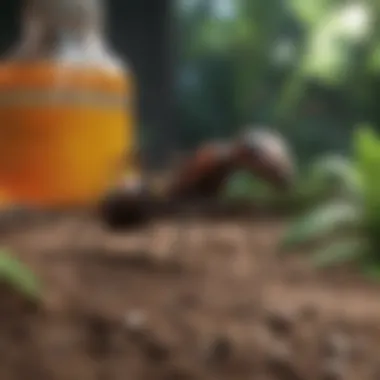

Landscaping Tips to Deter Ants
Landscaping is not just about looks; it can also play a pivotal role in ant deterrence. Think of your yard as a fortress, where every plant and pathway is strategically placed to discourage unwelcome visitors.
- Plant Selection: Opt for flowers and shrubs that ants prefer to avoid, such as mint and lavender. Ants despise strong scents, so incorporating these plants could help create a barrier. Additionally, installing barriers like gravel or pebbles around your garden can make it harder for ants to traverse.
- Maintain Distance: Keep trees and shrubs trimmed and at least a foot away from your house. When plants touch the exterior, they create highways for ants to enter your home.
- Mulching Wisely: While mulch can be beneficial for your garden, loose organic mulch can also attract ants. Instead, consider using stone or gravel mulch.
- Limit Organic Matter: Ants can find a feast in decomposing organic matter, so compost responsibly. Make sure your compost pile is located away from your home and preferably in a closed container.
"By integrating these preventive measures, you'll not only keep ants at bay, but you'll foster a vibrant ecosystem in your own backyard."
Natural Remedies for Ant Control
Natural remedies for ant control are essential in maintaining a balanced ecosystem in your yard while effectively addressing ant invasions. Unlike chemical treatments that may disrupt the local environment or pose health risks, natural solutions offer a gentler approach, utilizing substances found in nature. These methods not only target the ants but also preserve beneficial insects like bees and ladybugs. Implementing natural remedies ensures that your garden remains a welcoming space for all sorts of life.
Utilizing Essential Oils
Essential oils have gained popularity as effective ant deterrents, thanks to their potent scents that can disorient and repel ants. Oils such as peppermint, tea tree, and lemon are particularly noted for their ant-repelling properties. You can create a simple spray by mixing a few drops of essential oil with water in a spray bottle. When you spot ant trails, apply the blend directly onto the areas where you’ve seen activity.
- Safety First: These natural deterrents are relatively safe to use around pets and children, but it’s wise to test a small area first to check for any allergic reactions.
- Multiple Applications: Depending on the weather, you might need to reapply the mixture every few days or after rain. Ants have a strong sense of smell, so fresh applications will keep them at bay.
"For those who want to keep their gardens free of chemical residues, essential oils offer an effective and fragrant option."
Diatomaceous Earth as a Barrier
Diatomaceous earth (DE) is a remarkable, non-toxic substance that acts like a physical barrier. Made from the fossilized remains of tiny aquatic organisms called diatoms, it’s lethal to ants without harming the surrounding environment. When ants come into contact with DE, it scratches their exoskeletons, leading to dehydration and, eventually, death. It’s crucial to choose food-grade diatomaceous earth for safety.
- How to Apply: Simply sprinkle a fine layer of DE along ant trails or around entry points into your home. Make sure to reapply after rainfall or heavy watering.
- Effectiveness: This method not only targets ants but can deter a variety of garden pests. However, be cautious when applying, as disrupting the earth can affect beneficial insects as well.
Homemade Baits and Traps
Creating homemade baits and traps is another effective strategy to manage ant populations. These solutions often combine common pantry items that are attractive to ants but toxic to them. By mixing ingredients like sugar, borax, and water, homeowners can craft baits that draw in ants while eradicating them over time.
- Basic Sugar-Borax Bait: Mix one part borax with three parts sugar and enough water to create a paste. Place this mixture in small containers where you notice ant activity.
- Check Regularly: Monitor the traps and replenish the bait as needed. This not only helps control the immediate problem but can assist in breaking the ant colony’s lifecycle as foraging ants take the bait back to their nests.
Using these natural remedies can help create a more harmonious interaction between your garden and the local ant population while effectively managing ant invasions.
Chemical Solutions for Ant Control
Controlling ants in your yard often requires a multi-faceted approach, where chemical solutions play a significant role. Homeowners facing persistent ant invasions may find themselves frustrated, perhaps even at their wits' end. It's crucial to understand that while natural remedies can offer some relief, chemical options can effectively target ant colonies directly, acting swiftly to reduce their numbers and restore peace to your garden spaces. Moreover, the precise application of these chemical solutions, coupled with a thorough understanding of how they work, can yield positive outcomes while mitigating potential risks to the surrounding environment.
This section serves as a guide to help you navigate the various chemical options available, including considerations of their usage and impact. Understanding the nuances of each solution not only empowers you to make informed decisions but also ensures that your approach aligns with your overall yard health goals.
Overview of Chemical Options
When it comes to chemical solutions for ant control, several products on the market can be effective. Here are a few that homeowners frequently turn to:
- Boric Acid: This is a common choice for targeting specific ant species. When ingested, it disrupts their digestive systems, ultimately leading to their demise. It’s often used in bait stations since it's more attractive to ants than other chemical options.
- Pyrethroids: These are synthetic versions of natural insecticides derived from chrysanthemum flowers. Pyrethroids are potent and act quickly, making them a popular choice for immediate ant control. However, caution is warranted as they can cause harm to beneficial insects.
- Fipronil: Typically used in professional pest treatments, Fipronil is effective in controlling various ant species. It interacts with the nervous system of ants, posing high lethality when ingested or contacted.
- Imidacloprid: This is another insecticide that works by interfering with the transmission of nervous impulses in insects. It’s regarded for its softness to the environment but should still be used judiciously to minimize potential harm to non-target species.
Before selecting a product, it’s wise to read user reviews and understand how others have successfully implemented these options. Always ensure that you are adhering to local regulations regarding chemicals to promote a responsible application.
Application Techniques and Safety Measures
Using chemical ant control solutions effectively requires more than just spraying and hoping for the best. Here are key practices to consider:
- Targeted Application: Use bait stations where you notice high ant activity rather than blanket spraying over your yard. This method minimizes chemical exposure to other wildlife and pets.
- Timing is Everything: Apply treatments during cooler parts of the day; this is when ants are more active and likely to encounter the bait. Early morning or late afternoon is often preferable.
- Follow Instructions: Always read and follow the product label instructions. Each chemical has different recommended amounts and techniques for application, and adhering to these guidelines is vital for safety.
- Protective Gear: Don’t skimp on safety. Wear gloves, goggles, and a mask if required, especially when handling or mixing chemicals. Taking these precautions protects not only your health but also helps prevent cross-contamination.
- Monitor the Area: After applying the chemical solution, observe the area for signs of effectiveness and potential issues. If you notice any health concerns with local wildlife or pets, reassess usage and consult with a professional.
Important Note: While chemical solutions can provide quick results, striking a balance between effective ant control and ecological considerations is essential for maintaining a healthy garden environment.
Ultimately, a holistic approach that combines chemical solutions with ongoing monitoring and preventive measures ensures a comprehensive strategy for dealing with ants. Following these guidelines will equip you with the knowledge needed to tackle ant infestations effectively while keeping your outdoor space safe and thriving.
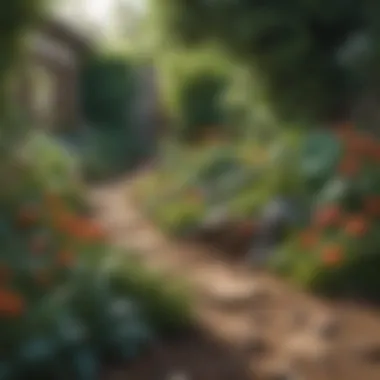

Impact on the Ecosystem
The relationship between gardening practices and the ecosystem is intricate, especially when it comes to managing ant populations. Understanding the impact of ants extends beyond their nuisance value; it touches on the fundamental aspects of ecological balance. Garden owners often focus on merely eliminating ants, but this approach can overlook the numerous contributions these insects make to soil health, biodiversity, and pest control.
Role of Ants in the Garden
Ants can serve as the unsung heroes of the garden. They aerate the soil by tunneling, improving drainage and promoting root growth. This natural process enables water and nutrients to penetrate deeper into the ground, benefiting not only the plants but also the microorganisms that play a vital role in nutrient cycling. Moreover, ants are known to prey on various pest populations, including aphids and caterpillars, aiding in controlling infestations without human intervention.
Here are a few key roles that ants play in the garden:
- Soil Aeration: Ants create tunnels that help aerate the soil, making it easier for roots to absorb water and nutrients.
- Seed Dispersal: Some ant species collect seeds and transport them back to their nests, contributing to the spread of plants and fostering biodiversity.
- Natural Pest Control: They keep other pest populations in check, often preventing these pests from becoming a real problem in gardens.
While it’s easy to focus on the unwanted aspects of ants, recognizing their beneficial roles is essential for a more sustainable approach to garden management.
Balancing Ant Control with Ecological Health
Navigating the waters of ant control requires a delicate balance. While homeowners have valid concerns about overpopulation and potential property damage, an ecosystem-centric approach is crucial. It's not just about eliminating pests; it's about preserving the intricate web of life that exists in your yard. This means not resorting to drastic chemical methods that could wipe out entire populations of beneficial insects.
A few strategies that blend ant control with ecological health include:
- Targeted Treatments: Instead of blanket chemical sprays, using targeted baits that harm ants but spare beneficial insects can be effective.
- Encouraging Beneficial Species: Attracting predators like birds and beneficial insects can help keep the ant population in check without compromising the ecosystem.
- Creating Barriers: Simple physical barriers or traps can deter ants without the need for toxic substances. For instance, using diatomaceous earth can act as a natural deterrent while allowing other insects to thrive.
When managing ants, considerations should extend beyond immediate concerns. A comprehensive strategy that respects both the ecosystem and the homeowner's needs will yield better results in the long run. After all, ants are part of a larger narrative that includes countless organisms playing their part in the garden's story.
"In gardening, understanding the role of each organism is as vital as planting and watering. A balanced ecosystem leads to a thriving garden."
By respecting the balance of nature within your yard, you create a sustainable environment that is not only ant-friendly but also beneficial for the myriad of other species that share the space.
Monitoring and Follow-Up
Understanding the importance of monitoring and follow-up in your ant control strategies is crucial. After you've taken steps to eliminate ants from your yard, it's not merely a case of waiting and hoping for the best. Continuous observation is necessary to ensure that your efforts yield the desired results and to determine if further action is needed. This step can save you time and resources in the long run.
Staying vigilant allows you to identify any new ant activity. If you notice fresh trails or mounds, it may indicate that the infestation wasn't fully addressed, which means revisiting your strategies is essential. Beyond just spotting ants, monitoring also involves assessing the state of your garden. Are the plants thriving? Is the soil balanced and healthy? Such checks not only keep ants at bay but can highlight other potential issues.
"An ounce of prevention is worth a pound of cure." Keeping a close eye on your surroundings often means catching problems before they escalate.
Evaluating the Effectiveness of Your Strategy
Evaluating the effectiveness of your initial ant control methods is a key component to ensure your yard remains ant-free. To do this, reflect on several factors:
- Reassessment of Ant Activity: After implementing your strategy, watch for the return of ant trails or nests. If you see a drop in activity, your methods are likely effective.
- Plant Health: Look at the overall condition of your garden. Plants that are thriving suggest a healthy ecosystem that is less appealing to ants.
- Feedback on Treatments: If you opted for specific products, check reviews or communities, such as those in forums like Reddit, to gauge their effectiveness. You might find surprising insights.
Make it a habit to log your observations. Document the state of your yard, noting any patterns or changes you observe. This log can be invaluable for you recognizing effective tactics that work to keep ants at bay. Over time, you'll develop a clearer picture of how your yard interacts with these little critters.
Long-Term Prevention Techniques
Preventing future ant infestations requires thoughtful planning and consistent upkeep. Here are some techniques that can aid in long-term success:
- Regular Clean-Ups: Maintaining a tidy garden is vital, as crumbs and organic debris attract ants. Schedule routine clean-ups, especially after parties or gatherings.
- Mulch Selection: Use non-organic mulch, as it is less likely to attract pests. This choice reduces available food sources for ants.
- Water Management: Ants are often drawn to moist environments. Ensure your yard doesn't have standing water or overly saturated areas, which can create an ideal habitat for them.
- Barriers: Consider installing physical barriers, such as ant-proof barriers around the perimeter of your garden, to deter ants from crossing into your territory.
Incorporating these practices not only keeps ants at bay but enhances the overall health of your garden. Ongoing vigilance and adaptive strategies are what separate a flourishing, ant-free garden from one that is always battling infestations.
Finale
In summation, addressing ant infestations in your yard isn’t just about the immediate inconvenience they cause; it speaks volumes about maintaining the integrity and vibrancy of your garden space. The strategies you employ can make the difference between a thriving ecosystem and one plagued by issues stemming from runaway ant populations. Each method—from preventive measures to natural and chemical interventions—serves not only the purpose of eliminating ants but also contributes to the health of your garden environment.
Recap of Strategies and Practices
- Understanding the Ant Landscape
Gaining a clear view of the types of ants that may invade your outdoor space is the first step. This knowledge helps tailor your approach, ensuring that you use the right tactics for the right species. - Prevention Takes Center Stage
Regularly cleaning your yard, sealing potential entry points, and making mindful landscaping choices can be some of the best defenses against unwanted invaders. It’s often easier to prevent an infestation than to deal with a full-blown problem. - Embrace Natural Remedies
Utilizing simple ingredients like vinegar or essential oils can effectively deter ants without harming the local ecological balance—this paves the way for sustainable gardening practices. - Chemical Solutions When Necessary
While not always the first choice, sometimes, harsher tactics become essential. Understanding how to safely apply these chemical solutions ensures both effectiveness and safety for your plants and pets. - Monitor and Adapt
Even the best-laid plans may need adjustments. Keeping tabs on the results of your efforts can help you refine your strategies, ensuring that your yard remains a comfortable environment for both you and beneficial insects.
"A garden isn't just a plot of land; it's a living ecosystem that thrives on balance."
As you reflect on these practices, consider the best integration into your regular gardening routine. Balancing effective ant control with conscientious ecological awareness is key to maintaining that lively garden you’ve always dreamed of.



